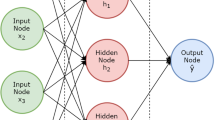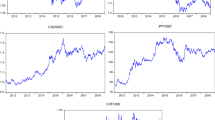Abstract
This paper looks at forecasting daily exchange rates for the United Kingdom, European Union, and China. Here, the authors evaluate the forecasting performance of neural networks (NN), vector singular spectrum analysis (VSSA), and recurrent singular spectrum analysis (RSSA) for forecasting exchange rates in these countries. The authors find statistically significant evidence based on the RMSE, that both VSSA and RSSA models outperform NN at forecasting the highly unpredictable exchange rates for China. However, the authors find no evidence to suggest any difference between the forecasting accuracy of the three models for UK and EU exchange rates.
Similar content being viewed by others
References
Hassani H, Soofi A S, and Zhigljavsky A A, Predicting daily exchange rate with singular spectrum analysis, Nonlinear Analysis: Real World Applications, 2010, 11: 2023–2034.
Hassani H, Heravi, H, and Zhigljavsky, A, Forecasting European industrial production with singular spectrum analysis, International Journal of Forecasting, 2009, 25: 103–118.
Hassani H, Mahmoudvand R, and Yarmohammadi M, Filtering and de-noising in linear regression analysis, Fluctuation and Noise Letters, 2010, 9: 343–358.
Hassani H and Thomakos D, A review on singular spectrum analysis for economic and financial time series, Statistics and Its Interface, 2010, 3: 377–397.
Hassani H and Zhigljavsky A, Singular spectrum analysis: Methodology and application to economics data, Journal of System Science and Complexity, 2009, 22(3): 372–394.
Yarmohammadi M, Measuring linear and nonlinear associations, Research Journal of Applied Sciences, Engineering and Technology, 2011, 5(5): 1480–1482.
Patterson K, Hassani H, Heravi S, and Zhigljavsky A, Forecasting the final vintage of the industerial production series, Journal of Applied Statistics, 2011, 38(10): 2183–2211.
Hassani H, Heravi H, and Zhigljavsky A, Forecasting UK industrial production with multivariate singular spectrum analysis, Journal of Forecasting, 2012, 32: 395–408.
Cassiano K, Junior L, Souza R, Moises M, Pessanha J, and Souza R, Hydroelectric energy forecast, International Journal of Energy and Statistics, 2013, 1(3): 205–214.
Hassani H and Mahmoudvand R, Multivariate singular spectrum analysis: A general view and new vector forecasting approach, International Journal of Energy and Statistics, 2013, 1: 55–83.
Beneki C and Silva E S, Analysing and forecasting European Union energy data, International Journal of Energy and Statistics, 2013, 1: 127–141.
Hassani H, Soofi A S, and Zhigljavsky A, Predicting inflation dynamics with singular spectrum analysis, Journal of the Royal Statistical Society A, 2013, 176: 743–760.
Qadrdan M, Ghodsi M, and Wu J, Probabilistic wind power forecasting using a single forecast, International Journal of Energy and Statistics, 2013, 1: 99–111.
Hassani H, Mahmoudvand R, and Zokaei M, Separability and window length in singular spectrum analysis, Comptes Rendus Mathematique, 2011, 349(17): 987–990.
Junior L A T, Menezes M L De, Cassiano K M, Pessanha J F M, and Souza R C, Residential electricity consumption forecasting using a geometric combination approach, International Journal of Energy and Statistics, 2013, 1: 113–125.
Kuan C M and Liu T, Forecasting exchange rates using feedforward and recurrent neural networks, Journal of Applied Econometrics, 1995, 10: 347–364.
Leung M T, Chen A S, and Daouk H, Forecasting exchange rates using general regression neural networks, Computers & Operations Research, 2000, 27: 1093–1110.
Tenti P, Forecasting foreign exchange rates using recurrent neural networks, Applied Artifical Intelligence, 1996, 10: 567–582.
Nag A K and Mitra A, Forecasting daily foreign exchange rates using genetically optimized neural networks, Journal of Forecasting, 2002, 21: 501–511.
Zhang G and Hu M Y, Neural network forecasting of the British Pound/US Dollar exchange rate, Omega, 1998, 26: 495–506.
Yao J and Tan C L, A case study on using neural networks to perform technical forecasting of forex, Neurocomputing, 2000, 34: 79–98.
Hann T H and Steurer E, Much ado about nothing? Exchange rate forecasting: Neural networks vs linear models using monthly and weekly data, Neurocomputing, 1996, 10: 323–339.
Oyewale A M, Evaluation of artificial neural networks in foreign exchange forecasting, American Journal of Theoretical and Applied Statistics, 2013, 2: 94–101.
Pradhan R P and Kumar R, Forecasting exchange rate in India: An application of artificial neural network model, Journal of Mathematics Research, 2010, 2: 111–117.
Hyndman R J and Athanasopoulos G, Forecasting: Principles and Practice, OTexts, Australia, 2013. OTexts.com/fpp.
Broomhead D S and King G P, Extracting qualitative dynamics from experimental data, Physica D, 1986, 20: 217–236.
Broomhead D S and King G P, On the qualitative analysis of experimental dynamical systems, In Nonlinear Phenomena and Chaos S, (ed.) Adam Hilger: Bristol, 2008, 113–144.
Golyandina N, Nekrutkin V, and Zhigljavsky A, Analysis of Time Series Structure: SSA and Related Techniques, Chapman & Hall/CRC, 2001.
Hassani H, Singular spectrum analysis (SSA): Methodology and comparison, Journal of Data Science, 2007, 5: 239–257.
Zhang G, Patuwo B E, and Hu M Y, Forecasting with artificial neural networks: The state of the art, International Journal of Forecasting, 1998, 24: 35–62.
Harvey D I, Leybourne S J, and Newbold P, Testing the equality of prediction mean squared errors, International Journal of Forecasting, 1997, 13: 281–291.
Author information
Authors and Affiliations
Corresponding author
Additional information
This research was supported by a grant from Payame Noor University, Tehran-Iran.
This paper was recommended for publication by Editor WANG Shouyang
Rights and permissions
About this article
Cite this article
Beneki, C., Yarmohammadi, M. Forecasting exchange rates: An optimal approach. J Syst Sci Complex 27, 21–28 (2014). https://doi.org/10.1007/s11424-014-3304-5
Received:
Revised:
Published:
Issue Date:
DOI: https://doi.org/10.1007/s11424-014-3304-5




